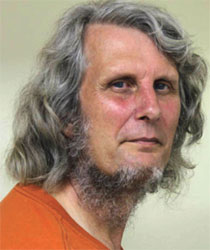|
February 2016

Issue Home >>
|

 Legend has it that every man’s dream job is that of rock star. For some, the next best thing to rocking out on a stage to thousands of screaming fans is rocking out in the top 5% of 32 million researchers visited at one website. Legend has it that every man’s dream job is that of rock star. For some, the next best thing to rocking out on a stage to thousands of screaming fans is rocking out in the top 5% of 32 million researchers visited at one website.
To add another layer of pun to this story, this rock star of academia is Brent Wilson, Professor of Palaeontology and Geology at St Augustine’s Department of Chemical Engineering, Petroleum Geoscience Programme. In January alone his work posted on the site Acadmia.edu received 75 profile views and 65 document views from 45 unique visitors, which put him in the top 5% of all 32 million researchers hosted by the site.
While tenured at The UWI, he has published 55 papers in refereed journals, and 14 articles in newspapers and books. He has presented research seminars on his work at:
- • Smithsonian Institution, Washington D.C., of which he was made a research associate in 2014,
- Bedford Institution of Oceanography, Dartmouth, Canada,
- Dalhousie University, Halifax, Canada,
- IFM-Geomar-Institute, Kiel, Germany,
- Anton de Kom University, Suriname
- University of Georgia, Athens, USA.
A frequent reviewer for papers submitted to Palaios, Marine Micropaleontology and Biogeochemistry, Professor Wilson is the Caribbean correspondent for the popular magazine Geology Today and an associate editor of the prestigious Journal of Foraminiferal Research, focussing on the biostratigraphy of the last 25 million years. He is a Fellow of the Cushman Foundation for Foraminiferal Research, and served as a Director of the Geological Society of Trinidad and Tobago from 2008 – 2015, to which he is a frequent technical presenter and for which he aided in organising the 20th Caribbean Geological Conference in 2015. He has supervised graduate students working on micropalaeontology, sedimentology and volcanology.
This literal and academic rock star is also frequently called on by BHP Billiton regarding the use of micropalaeontology in their oil and gas exploration and is currently playing a large role in the commercialisation of micropalaeontological services within his Department. These services are proving to be in high demand. The Ministry of Energy and Energy Industries has recognised the value of Wilson’s work, awarding him a sizeable grant to investigate some of the new techniques that he has developed. Furthermore, oil giant BPTT has over the past decade repeatedly given him funds to allow him to involve students in his research, thus giving them a chance to experience the rigours, techniques and excitement of research first hand.
Moving from Nevis to Trinidad in 1998, Professor Wilson initially worked as a biostratigrapher in the oil industry, using fossil foraminifera to tell the ages of sedimentary rocks and the environments in which they had been deposited. He joined the Petroleum Geoscience Programme in 2003 to lecture in palaeontology, sedimentology and stratigraphy, using his experience from Nevis and industry. His research on microscopic fossils at the UWI has concentrated on two aspects especially:
- using them to decipher the geological history of Trinidad during Miocene times (23 – 5 million years ago), when the mountain building associated with the Northern Range led to huge changes in sea level elsewhere on the island, and
- using them to unravel the impact of the Orinoco River on the island’s geological history since the river first began flowing towards the east about 7 million years ago.
Professor Wilson’s prolific research has arisen from his ability to find and fill gaps in our knowledge while using a minimum of equipment. During the 1940s through 1960s, Trinidad was a global centre for work in micropalaeontology (the study of microscopic fossils). With the nationalisation of much of the oil and gas industry in the 1970s, however, academic research in micropalaeontology here in Trinidad and Tobago came to a virtual standstill but continued elsewhere. There were thus many opportunities when Wilson joined the UWI simply applying up-to-date techniques to our local material. However, this was not all. Each research project, while answering some questions, raises other ones. Frequently answering these requires that new techniques be developed. He has been instrumental in developing some statistical techniques, such as the Assemblage Turnover Index, that have deepened insights into micropalaeontology worldwide. This is evidenced by the interest his work has garnered online. So the next time someone verbalises the dream of achieving rock star status, be sure to ask if that’s of sedimentary rock and its fossils. |





